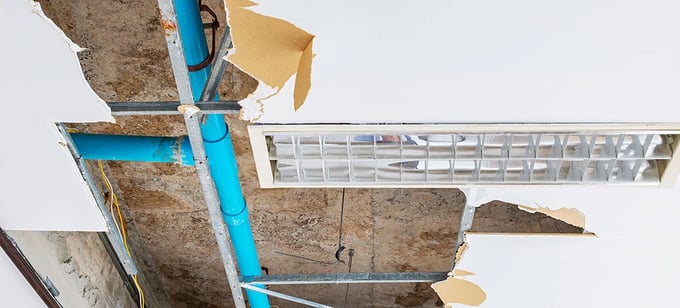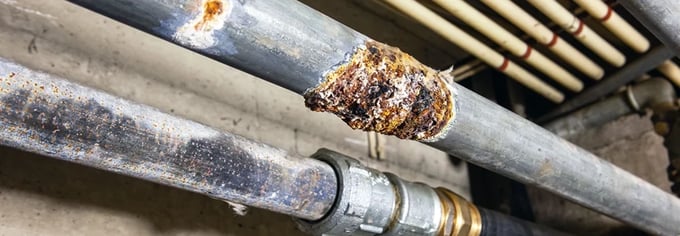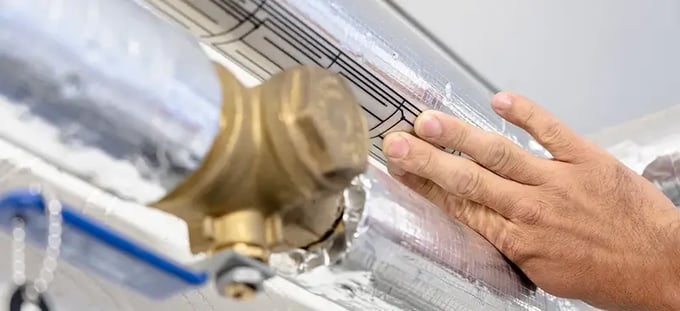A small water pipe leak in a wall, floor, or ceiling can easily be the costliest type of water damage you will ever experience in a commercial building.
When you imagine water damage in an office or multi-residential building, most people imagine pipes bursting, sinks or toilets backing up, or the parking garage flooding. And while these are most definitely crises you may face, they aren't the most expensive leaks you can experience.
When it comes to costly, damaging leaks, think small.
A tiny leak dripping inside your floors or walls will likely start completely unnoticed. It might go on for years before the damage begins to show or becomes a significant flood.
Even then, it can take even longer before anyone notices if you have a large facility and not enough staff or time to check every corner or behind wall units and large furniture.
The most expensive water leak is often the smallest
If a standard ½-inch pipe in your facility bursts, it can leak upwards of 3,000 gallons of water an hour. However, this isn't likely to last very long. People usually describe the sound of a pipe bursting as a loud bang accompanied by rattling and the sound of rushing water, depending on the size of the pipe.
You immediately know something's wrong and can quickly shut off the water and call for professional help, limiting the damage it can do. It will undoubtedly be expensive – water damage like this often reaches several hundred to thousands of dollars. Still, you can deal with it promptly, preventing any long-term damage to your building.
Let's say the same pipe has a small crack, leaking at a rate of 120 drops/ minute – a rapid but undramatic leak. If this is within a wall or floor, you will neither hear nor see it.
But at this rate, it will be leaking nearly 11.5 gallons of water daily. That's almost 4,200 gallons of water a year. This loss probably isn't enough to be noticed on your water bill – on average, in the United States, it amounts to a mere US$8.33. But the damage could be massive compared to the pipe burst described above.

How expensive this can get depends on a few factors. To simplify things, let's use the example of that 120 drip/ minute leak in an office building. It comes from a pipe under an office floor for 100 people, roughly 17,500ft2, and leaks for many weeks, if not months.
You notice the leak when water damage is visible in the ceiling of the floor below it. Let's say the leak has affected 2,000ft2 of the floor, walls, and ceiling, making this a Class 3 water intrusion.
The first cost is the removal of the water. If the pipe is for clean water, this alone might cost upwards of US$4.25 per ft2, or US$8,500. The cost will be substantially more if the pipe is used for drainage from a sink (US$13,000) or, unlikely for a pipe of this size, sewage (US$15,000) due to the increased health risks and contamination.
If the leak has affected the drywall, this will need to be repaired. The cost in the US can be upwards of US$3/ ft2. Let's say around 330ft2 of drywall needs to be replaced: that's another US$1,000.

But the worst part is that this leak has been going on for some time, leading to black mold growth, which can begin within just 24 hours after the leak starts. Black mold removal is very expensive, upwards of US$25/ ft2, depending on the species of mold.
If black mold is widespread in the drywall or insulation of even half of this 2,000ft2 section of this office – that quickly adds up to US$30,000 or more.
Of course, this only considers a few of the most basic costs of water damage. A leak gets substantially more costly if the water has caused structural damage, such as seeping into concrete or multilayered walls and floors or damaged electrical systems.
It also doesn't consider things like vacancy loss and lost business (no one can work in a water-damaged office while it's being repaired).
What then starts as a tiny pipe leak of just two drips can quickly become a huge US$40,000+ problem. And you won't know about it until most of the damage is already done.
The best way to protect yourself from little leaks
Wireless sensors and other smart building technology have been developed to prevent massive, expensive damage by helping you find and fix problems as soon as possible.
Our Severn Water Leak Detector is one such kind of sensor. We developed them to fit into the smallest, most awkward spaces where a person is least likely to notice a leak. Severn can be applied around pipes and joints like tape and, using LoRaWAN leak detection will alert you remotely if so much as two drops of water leak out.
